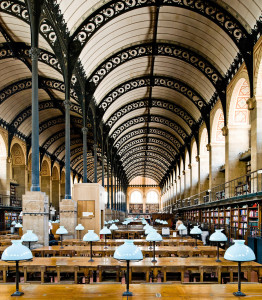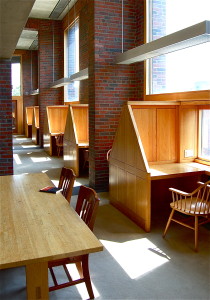This was my final paper for HIAA0850: Modern Architecture. Our prompt was to pick an architect, building type, singular building, building material, or building technique. I chose the Class of 1945 Library at Phillips Exeter. As an Exeter student, I had known that the library was architecturally significant. I was glad that I had the opportunity to learn why it was significant in HIAA85.
Louis Kahn’s Exeter Library: A Reinterpretation of the Ideal Reading Space
Louis Kahn’s Exeter Library (1969-1971) masterfully upends the traditional layout of libraries. At the time, most well-regarded libraries encircled a single, grand, high-ceilinged reading room with many individual floors of bookshelves (Figure 1). While the communal reading room impressed and awed the scholar by demonstrating the immense quantity of accumulated knowledge available to them, this design conflicted with Kahn’s vision of the ideal reading spot. Instead of a single, grandiose, reading room, Kahn pictured smaller, more private, and more intimate spaces next to outside windows: carrel desks. To integrate this vision into the Exeter Library, Kahn surrounded the traditional atrium and ring of bookshelves with another outer ring of carrels and tables next to large windows (Figure 1), keeping students close to the sun’s illuminating glow and books away from its damaging rays. Through this innovation and many others, Louis Kahn’s meticulous and thoughtful design of the Exeter Library earned the building the Twenty-Five Year Award from the American Institute of Architects. The Exeter Library is truly a hidden gem among Kahn’s monumental, modernist jewels.

